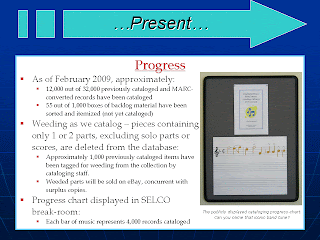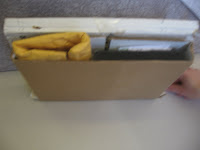Abstract:
After more than twenty years of collecting popular music on compact disc in the Music Library and Sound Recordings Archives (MLSRA) at Bowling Green State University (BGSU), the staff have begun the daunting task of cataloging this 30,000+ collection. With the help of technical services catalogers and numerous students, the cataloging began in earnest in July 2007. New cataloging and processing procedures were established in order to minimize errors, use music catalogers’ time more efficiently, and utilize all student staff to full potential. Overall, the project has run very smoothly in the past year. We were able to catalog around 11,000 CDs. In this poster session, we will present the procedures and tasks involved, along with the viewpoint from a student worker and a cataloging supervisor and show how we have been able to undertake the challenge of eliminating this backlog.
Presenters: Patricia Falk, Special Collections Cataloger, BGSU
John Cook, Graduate Student (Kent State)
Presentation:
Movin’ and Groovin: The Student and Supervisor Viewpoints of Original Cataloging of Popular Music CDs
Previous Procedures:
· Recordings searched by cataloger in OCLC for copy records
· Cataloger wrote out workform for originals and wrote out edits for copy cataloging, including authority work
· Recordings were processed on typewriter by students and shelved after processing
· Workforms were typed in OCLC by student assistants and checked by catalogers before being exported into local online catalog
Cons of Previous Procedures:
· Recordings were not included with workforms to check for accuracy
· Student typos due to catalogers’ handwriting
· Inconsistencies in call numbers
· Frequent errors in authority work
New Procedures:
· Materials are processed first, using a new Excel label program with laser printing
· Records are searched on OCLC for copy
· Copy edits go to cataloger and then to student assistants to add changes and check authority records and create authority records when necessary
· CDs requiring original cataloging are typed directly into OCLC by student assistants with CD in hand using a constant data template overlayed on a sound recording format workform; students also check authority records and create authority records when necessary
· Original workforms and CDs are checked by the Sound Recordings Archivist who also adds subjects and other pertinent information not provided by the student assistants
· Original workforms and CDs are then passed on to the Special Collections Cataloger for NACO additions and exporting to local catalog
Pros:
· Faster processing and cataloging of CDs
· Uses Sound Recordings Archivist’s time more efficiently
· Uses all student staff to full potential
Cons:
· CDs go through many processes and handling before being shelved
· Requires training of many students on various procedures by Special Collections Cataloger
· Creates a need to keep work flowing even when catalogers are busy with other materials as well
Training of Student Assistants:
· Training in OCLC Connexion is much more efficient and is usually complete in 4 hours with most students
· Students are shown how to type forms for various types of albums including single artist, remixes, and compilation albums
· Students are shown how to check authority file and create new authority records in OCLC Connexion and put into save file for Special Collections Cataloger to add later
· Students are given a cheat sheet that they can add to as needed and are provided with sample records
Pros:
· Students can catalog items faster and more accurately with CD in hand
· Students feel more invested when they realize the importance of getting CDs cataloged
· Students are allowed to pick which albums they want to catalog, with some exceptions
The Student ViewpointPros:
· Being involved with the various stages of the project (processing, cataloging, labeling, shelving, etc.) provided me with a comprehensive understanding of how the different tasks related to one another
· The compartmentalization of the different tasks provided me with the perspective to see how my individual work related to the overall goals of the project
· I received firsthand experience working in an academic library with a highly specialized collection
· I was given the opportunity to work closely with the BGSU MLSRA staff and had access to the extensive sound recordings archives
· I was thoroughly trained and I was able (and encouraged) to ask questions when I needed clarification
· I was exposed to a plethora of new popular music and genres
· Working at the BGSU MLSRA on this project was the catalyst to my enrollment in the Library and Information Science program at Kent State University
Cons:
· The lack of full Internet access at the student workstations made cataloging problematic sound recordings difficult (i.e. not having full access to useful website such as record labels, artists, allmusic.com, etc.)
· It was not until I had been working on the project for several months that I began to understand how the different tasks related to one another
· Having a complete and thorough understanding of how the project functioned at an earlier stage may have helped alleviate some of the confusion I had when I first started working on the project
The Supervisor’s ViewpointPros:
· Good work and progress we are achieving in this project
· Creating a close working relationship with more of our student staff and using all of their skills and abilities to get more accomplished
· Allows students at service window and reference desk to see more of our collection and the work involved in adding materials to our collection
· Creating a group effort
· Creating more accurate OCLC records and NACO records
· Making more efficient use of catalogers’ time
· Cataloged over 11,000 CDs in one year (This includes CDs cataloged in Technical Services as well as in the MLSRA)
Cons:
· Dealing with student turnover on a regular basis
· Making sure project keeps an even workflow between processing and cataloging
· Keeping up with shelving and shifting to make room for newly cataloged CDs
· Keeping track of supplies and making sure everyone has what they need in order to keep the project moving
· Being available to answer questions on a regular basis from student assistants and staff
· Taking on additional student tasks when student assistants are on break or unavailable
ConclusionOverall, this has been the biggest project I have overseen at BGSU since I began in 1997 as a library faculty member. It has been a learning experience and a true balancing act which I continue to perfect and amend as necessary. The project will probably take another two to three years to complete, not including the box sets, which will create other issues we will need to handle. I have enjoyed working with all of our students and hope to continue to move forward and finish this project as quickly as possible with help from students like John and others. As a supervisor, I truly value students that are willing to learn and contribute to our library and institution.
The following photos represent examples of authority records created by students from bibliographic records they have typed in OCLC and a bibliographic record with the cataloger's additions in red.


>

OCLC guide:
Log on:
Password:
New work form: CTRL + Shift + r
Constant data: CTRL=u
Select: sracd and "both"
Country codes: England=enk; Germany=gw; France=fr; Austria=au; Australia=at
DtSt: s=single; r=reissue
AccM: d=lyrics; f=biographical notes; i=program notes
024: UPC bar code
0241=United States
0243=European
028:Publisher number-02800=on container; 02802=on disc or other primary source; 02812=from matrix area
099:Local call number, separated by a
100: Author field 1000=no surname; 1001=surname, first name
1102: Corporate author
24500: For compilation albums (or 24502, 24503, 24504 for titles with initial articles)
24510: For albums with 100/110 field, always ends in period
5050: Contents, always ends in period
74002: Indivdual song titles from contents
























